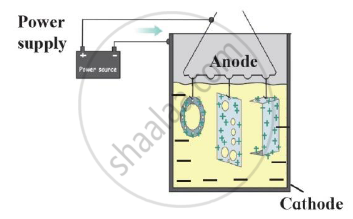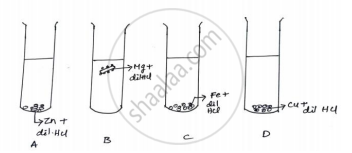Advertisements
Advertisements
प्रश्न
Compare roasting and calcination.
Distinguish between:
Roasting - Calcination
उत्तर
| Roasting | Calcination | |
| 1. | This method is generally used for sulphide ores | This method is generally used for carbonate ores. |
| 2. | In this method, ores are heated in excess of air. | In this method, ores are heated in a limited supply of air. |
| 3. | In roasting, generally sulphur dioxide gas is evolved. | In calcination, generally carbon dioxide gas is evolved. |
| 4. | In this method, sulphide ores are oxidized to form metal oxides. E.g. \[\ce{2ZnS + 3O2 -> 2ZnO + 2SO2↑}\] |
In this method, carbonate ores decompose to form metal oxide. E.g. \[\ce{ZnCO3 -> ZnO + CO2↑}\] |
संबंधित प्रश्न
Write two methods of preventing the rusting of iron.
Answer the following question.
What are alloys?
Explain how painting of an iron gate prevents it from rusting.
Explain why Iron sheets are coated with zinc during galvanization.
What is anodising? Give its applications.
The chemical reaction involved in the corrosion of iron metal is that of:
(a) oxidation as well as displacement
(b) reduction as well as combination
(c) oxidation as well as combination
(d) reduction as well as displacement
Explain why, iron sheets are coated with zinc.
Fill in the following blanks with suitable words:
............ and .............. are necessary for the rusting of iron.
Explain why, through aluminium is more reactive than iron, yet there is less corrosion of aluminium when both are exposed to air.
What is meant by 'rusting of iron'? With the help of labelled diagrams, describe an activity to find out the conditions under which iron rusts.
Name an alloy of copper. State its chemical composition and any one use.
Explain why, when a copper object remains in damp air for a considerable time, a green coating is formed on its surface. What is this process known as?
Explain why, the galvanised iron article is protected against rusting even if the zinc layer is broken.
Name a common metal which is highly resistant to corrosion.
A common metal which is highly resistant to corrosion is:
(a) iron
(b) copper
(c) aluminium
(d) magnesium
If copper is kept exposed to damp air for a considerable time, it gets a green coating on its surface. This is due to the formation of:
(a) hydrated copper sulphate
(b) copper oxide
(c) basic copper carbonate
(d) copper nitrate
A metal X which is resistant to corrosion is produced by the electrolysis of its molten oxide whereas another metal Y which is also resistant to corrosion is produced by the reduction of its oxide with carbon. Metal X can be used in powder form in thermite welding whereas metal Y is used in making cathodes of ordinary dry cells.
(a) Name the metals X and Y.
(b) Which of the two metals is more reactive : X or Y?
(c) Name one ore or metal X. Also write its chemical formula.
(d) Name one ore or metal Y. Also write its chemical formula.
(e) Name one alloy of metal X and one alloy of metal Y.
Bronze is an alloy of ______.
Explain how the activity series accounts for each of the following:
tendency to corrosion
Explain with reason:
Roasting is carried out on sulphide ores and not on carbonate ores.
No chemical reaction takes place when granules of a solid, A, are mixed with the powder of another solid, B. However when the mixture is heated, a reaction takes place between its components. One of the products, C, is a metal and settles down in the molten state while the other product, D, floats over it. It was observed that the reaction is highly exothermic.
(i) Based on the given information make an assumption about A and B and write a chemical equation for the chemical reaction indicating the conditions of reaction, physical state of reactants and products and thermal status of reaction.
(ii) Mention any two types of reactions under which above chemical reaction can be classified.
Observe the following picture a write down the chemical reaction with the explanation.

Identify the process shown in the diagram and explain it in short

Find the odd man out:
What is "rusting"? Describe with a labelled diagram an activity to investigate the conditions under which iron rusts.
Observe the following picture and answer the following questions:

- What is rust?
- Write the chemical formula of rust.
- Write the reaction of oxidation of iron at the anode.
- Write the reaction of oxidation of iron at the cathode.
- What is corrosion?
_______ is an alloy made from iron, carbon and chromium.
Stainless steel is an alloy of _______.
Pressure cooker : Anodizing : : Silver plated spoons : _______
Find the odd one out and give its explanation.
Find the odd one out and give its explanation.
Match the columns.
| Group A | Group B |
| 1) Electroplating | a) Pressure cooker |
| 2) Anodising | b) Silver plated spoons |
| c) Coating of tin on copper | |
| d) Coating of Zinc on iron |
Write the name.
Method used to prevent corrosion of copper.
Write scientific reason.
Anodization method is useful for prevention of the corrosion of the aluminium.
Draw a neat labelled diagram.
Electroplating
Draw a neat labelled diagram.
Anodizing
Write a molecular formula for rust.
Give preventive methods by giving examples of corrosion?
Amalgam is an alloy of ____________.
The diagram shows the reaction between metal and dil. acid.

What is the reason for different behaviour of Mg in test tube B?
State whether the following statements are true or false:
Ships suffer a lot of damage though they are painted.
Explain the following:
Bubbles are produced when acetic acid is added to a solution of sodium hydrogencarbonate.
Give an example of a chemical reaction for each of the following situations:
Sound is produced
| A process of forming a thick oxide of aluminium when aluminium is exposed to air. This coat makes it resistant to corrosion. Resistance can be improved by making a layer of oxide thinker. In this technique, the aluminium article is the anode, and the electrolyte is sulphuric acid. The anode reaction results in the formation of a black-coloured film of aluminium oxide on the anode. By putting appropriate dyes in the electrolytic solution, both coloured surface with the decorative finish is achieved. Kitchen articles like anodised such as pressure cookers, pans and frames of sliding windows are applications of this technique. |
- Name the anode and electrolyte used in this technique.
- How can we make aluminium articles made resistant to corrosion?
- Name the technique used to coat the aluminium articles.
Describe two changes that are harmful. Explain why you consider them harmful. How can you prevent them?
